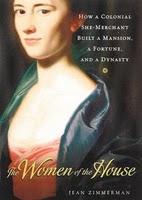The Women of the House: How a Colonial She-Merchant Built a Mansion, a Fortune, and a Dynasty

Margaret Hardenbroeck Philipse, the first woman to build her own lavish fortune in the New World, had the Midas touch when it came to trading everything from furs to slaves in seventeenth century colonial Manhattan, then called New Amsterdam. When Margaret arrived on a ship from Holland, she was only twenty-two years old, independent and determined to “squeeze the honey out of this land, to transform that honey into gold.” By the time of her death a few decades later, Margaret had created a vast real estate empire from Albany to Barbados, commandeered a fleet of trading ships that carried slaves, furs, tobacco, textiles and molasses, and set the tone for the dynasty to follow into the next century.
What’s most fascinating about the book – even more than the character portrayal of Margaret herself, which at some points verges on a clichéd portrait of obsessive greed, ‘workaholism’ and zero empathy for the exploited – is Zimmerman’s tight zoom into the cultural mores of the times. We learn in thrilling detail the progressive, permissive laws of the Dutch and their embrace of equal rights for women vs. the oppressive patriarchal English who later take over New Amsterdam without firing a single shot.
The wealth of historical detail continues as the book shifts to mini-portraits of the women, who follow in formidable Margaret’s wake, on the grand Westchester estate called Philipse Manor Hall: Catherine Van Cortlandt Philipse, who wed Margaret’s widowed husband Frederick and built a grand church; Joanna Brockholst Philipse, the ultimate political wife who married Margaret’s grandson, and Joanna’s daughter, Mary Philipse Morris, the “It” girl of the mid-1700s.
It’s the American dream with a feminist twist: spirit, determination, genius, resourcefulness, and setbacks such slave revolts and the American Revolution, after which the dynasty was tarred as Loyalist.
I wonder when I come upon an inspiring book like this, why still there is persistence to either not mention, or gloss over, the roles of women in American history whose contributions surpassed the traditional role of wife and mother. Margaret – twice married, a mother of five and a flinty woman, who created enough wealth to claim a place as the richest woman in New York in her time – deserves a prominent mention in American history books. Thankfully, Jean Zimmerman gives this incredibly remarkable and accomplished woman her due.